A Study on Modified Bitumen with Metal Doped Nano-TiO2 Pillared Montmorillonite
Abstract
:1. Introduction
2. Materials and Methods
2.1. Materials
2.2. Synthesis of TiO2 and Metal Doped TiO2 Pillared Montmorillonite
2.3. Preparation of Modified Bitumen
2.4. Microscopic Tests of Samples
2.5. High Temperature Rheological Tests
2.6. Ultraviolet (UV) Aging Test
2.7. Degradation Test of Automobile Exhaust
3. Results and Discussion
3.1. Microscopic Characterization of Samples
3.2. High Temperature Rheological Properties of Modified Bitumen
3.3. UV Aging of Modified Bitumen
3.4. Photocatalytic Degradation of Tail Gas Test
4. Conclusions
- (1)
- The interlayer spacing of Cu-T/M, Fe-T/M, and Ce-T/M was further expanded compared to that of MMT, indicating that Cu-T/M, Fe-T/M, and Ce-T/M were successfully synthesized.
- (2)
- The optical absorption edges of Cu-T/M, Fe-T/M, and Ce-T/M were red shift, and the UV absorption capacity was enhanced compared to that of T/M. Further, the absorption range of the metal doped modified bitumen was extended from UV to visible light, which improved the UV aging resistance and photocatalytic properties of the modified bitumen. The red shift of absorption edge of Cu-T/M is the most obvious, and the absorption range of ultraviolet is the most extensive.
- (3)
- After the three different dosage modifiers for Cu-T/M, Fe-T/M, and Ce-T/M were added to the bitumen, the G*/sinδ of the modified bitumen was significantly improved at different temperatures, while the δ decreased. The high temperature rheological properties of the three kinds of modified bitumen were optimal with the dosage of 5 wt %, and Ce-T/M features the best high temperature rheological properties among the three kinds of modified bitumen.
- (4)
- 5 wt % Ce-T/M modified bitumen had the lowest AI value at different temperatures in the temperature range of 40–70 °C, indicating the best UV aging resistance for the bitumen.
- (5)
- The degradation rate of NO and HC gas is obviously improved by doping with Cu, Ce, and Fe. The degradation order is: Cu-T/M > Ce-T/M > Fe-T/M > T/M. Cu-T/M exhibits the best excellent photocatalytic performance for HC and NO gases.
- (6)
- Only the degradation rate of modified bitumen at 25 °C was studied in this paper, and the effect of different environments on the degradation rate of modified bitumen was not considered. The next step will aim at studying the effects of different temperatures and humidity on the degradation rate of modified bitumen.
Author Contributions
Funding
Conflicts of Interest
References
- Zeng, W.; Wu, S.; Pang, L.; Chen, H.; Hu, J.; Sun, Y.; Chen, Z. Research on Ultra Violet (UV) aging depth of asphalts. Constr. Build. Mater. 2018, 160, 620–627. [Google Scholar] [CrossRef]
- Rafi, J.; Kamal, M.A.; Ahmad, N.; Hafeez, M.; Haq, M.F.U.; Asif, S.A.; Shabbir, F.; Zaidi, S.B.A.; Kamal, M.A. Performance Evaluation of Carbon Black Nano-Particle Reinforced Asphalt Mixture. Appl. Sci. 2018, 8, 1114. [Google Scholar] [CrossRef]
- Lv, S.; Xia, C.; Liu, C.; Zheng, J.; Zhang, F. Fatigue equation for asphalt mixture under low temperature and low loading frequency conditions. Constr. Build. Mater. 2019, 211, 1085–1093. [Google Scholar] [CrossRef]
- Li, J.; Xu, G.; Chen, Y.; Liu, G. Multiple scaling investigation of magnesium phosphate cement modified by emulsified asphalt for rapid repair of asphalt mixture pavement. Constr. Build. Mater. 2014, 69, 346–350. [Google Scholar] [CrossRef]
- Jin, J.; Xiao, T.; Tan, Y.; Zheng, J.; Liu, R.; Qian, G.; Wei, H.; Zhang, J. Effects of TiO2 pillared montmorillonite nanocomposites on the properties of asphalt with exhaust catalytic capacity. J. Clean. Prod. 2018, 205, 339–349. [Google Scholar] [CrossRef]
- Wu, S.; Zhao, Z.; Li, Y.; Pang, L.; Amirkhanian, S.; Riara, M. Evaluation of Aging Resistance of Graphene Oxide Modified Asphalt. Appl. Sci. 2017, 7, 702. [Google Scholar] [CrossRef]
- Bee, S.-L.; Abdullah, M.; Bee, S.-T.; Sin, L.T.; Rahmat, A. Polymer nanocomposites based on silylated-montmorillonite: A review. Prog. Polym. Sci. 2018, 85, 57–82. [Google Scholar] [CrossRef]
- Jin, J.; Tan, Y.; Liu, R.; Zheng, J.; Zhang, J. Synergy Effect of Attapulgite, Rubber, and Diatomite on Organic Montmorillonite-Modified Asphalt. J. Mater. Civ. Eng. 2019, 31, 04018388. [Google Scholar] [CrossRef]
- Jamil, A.; Oh, P.C.; Shariff, A.M.; Ching, O.P. Polyetherimide-montmorillonite mixed matrix hollow fibre membranes: Effect of inorganic/organic montmorillonite on CO2/CH4 separation. Sep. Purif. Technol. 2018, 206, 256–267. [Google Scholar] [CrossRef]
- Jin, J.; Tan, Y.; Liu, R.; Lin, F.; Wu, Y.; Qian, G.; Wei, H.; Zheng, J. Structure characteristics of organic bentonite and the effects on rheological and aging properties of asphalt. Powder Technol. 2018, 329, 107–114. [Google Scholar] [CrossRef]
- Yu, J.-Y.; Feng, P.-C.; Zhang, H.-L.; Wu, S.-P. Effect of organo-montmorillonite on aging properties of asphalt. Constr. Build. Mater. 2009, 23, 2636–2640. [Google Scholar] [CrossRef]
- Ren, H.; Koshy, P.; Chen, W.-F.; Qi, S.; Sorrell, C.C. Photocatalytic materials and technologies for air purification. J. Hazard. Mater. 2017, 325, 340–366. [Google Scholar] [CrossRef] [PubMed]
- Wang, H.; Jin, K.; Dong, X.; Zhan, S.; Liu, C. Preparation Technique and Properties of Nano-TiO2 Photocatalytic Coatings for Asphalt Pavement. Appl. Sci. 2018, 8, 2049. [Google Scholar] [CrossRef]
- Nguyen, L.T.T.; Nguyen, L.T.H.; Duong, A.T.T.; Nguyen, B.D.; Hai, N.Q.; Chu, V.H.; Nguyen, T.D.; Bach, L.G. Preparation, Characterization and Photocatalytic Activity of La-Doped Zinc Oxide Nanoparticles. Materials 2019, 12, 1195. [Google Scholar] [CrossRef] [PubMed]
- Yang, C.; Zhu, Y.; Wang, J.; Li, Z.; Su, X.; Niu, C. Hydrothermal synthesis of TiO2–WO3–bentonite composites: Conventional versus ultrasonic pretreatments and their adsorption of methylene blue. Appl. Clay Sci. 2015, 105, 243–251. [Google Scholar] [CrossRef]
- Jin, J.; Lin, F.; Liu, R.; Xiao, T.; Zheng, J.; Qian, G.; Liu, H.; Wen, P. Preparation and thermal properties of mineral-supported polyethylene glycol as form-stable composite phase change materials (CPCMs) used in asphalt pavements. Sci. Rep. 2017, 7, 16998. [Google Scholar] [CrossRef]
- Sahel, K.; Bouhent, M.; Belkhadem, F.; Ferchichi, M.; Dappozze, F.; Guillard, C.; Figueras, F. Photocatalytic degradation of anionic and cationic dyes over TiO2 P25, and Ti-pillared clays and Ag-doped Ti-pillared clays. Appl. Clay Sci. 2014, 95, 205–210. [Google Scholar] [CrossRef]
- Pelaez, M.; Nolan, N.T.; Pillai, S.C.; Seery, M.K.; Falaras, P.; Kontos, A.G.; Dunlop, P.S.; Hamilton, J.W.; Byrne, J.; O’Shea, K.; et al. A review on the visible light active titanium dioxide photocatalysts for environmental applications. Appl. Catal. B Environ. 2012, 125, 331–349. [Google Scholar] [CrossRef] [Green Version]
- Jin, J.; Xiao, T.; Zheng, J.; Liu, R.; Qian, G.; Xie, J.; Wei, H.; Zhang, J.; Liu, H. Preparation and thermal properties of encapsulated ceramsite-supported phase change materials used in asphalt pavements. Constr. Build. Mater. 2018, 190, 235–245. [Google Scholar] [CrossRef]
- Standard Method of Test for Determining the Rheological Properties of Asphalt Binder Using a Dynamic Shear Rheometer (DSR); AASHTO T315-2012; American Association of State Highway Transportation Officials: Washington, DC, USA, 2012.
- Wei, H.; Bai, X.; Qian, G.; Wang, F.; Li, Z.; Jin, J.; Zhang, Y. Aging Mechanism and Properties of SBS Modified Bitumen under Complex Environmental Conditions. Materials 2019, 12, 1189. [Google Scholar] [CrossRef]
- Zhang, W.; Zhang, Y.; Jia, Z.; Wang, F.; Ding, L. Test method and material design of asphalt mixture with the function of photocatalytic decomposition of automobile exhaust. Constr. Build. Mater. 2019, 215, 298–309. [Google Scholar] [CrossRef]
- Liu, W.; Wang, S.; Zhang, J.; Fan, J. Photocatalytic degradation of vehicle exhausts on asphalt pavement by TiO2/rubber composite structure. Constr. Build. Mater. 2015, 81, 224–232. [Google Scholar] [CrossRef]
- Hu, Z.; Xu, T.; Fang, B. Photocatalytic degradation of vehicle exhaust using Fe-doped TiO2 loaded on activated carbon. Appl. Surf. Sci. 2017, 420, 34–42. [Google Scholar] [CrossRef]
- Cao, X.; Yang, X.; Li, H.; Huang, W.; Liu, X. Investigation of Ce-TiO2 photocatalyst and its application in asphalt- based specimens for NO degradation. Constr. Build. Mater. 2017, 148, 824–832. [Google Scholar] [CrossRef]
- Torres-Luna, J.A.; Sanabria, N.R.; Carriazo, J.G. Powders of iron(III)-doped titanium dioxide obtained by direct way from a natural ilmenite. Powder Technol. 2016, 302, 254–260. [Google Scholar] [CrossRef]
- Dvoranová, D.; Brezová, V.; Mazúr, M.; Malati, M.A. Investigations of metal-doped titanium dioxide photocatalysts. Appl. Catal. B Environ. 2002, 37, 91–105. [Google Scholar] [CrossRef]
- Mathew, S.; Ganguly, P.; Rhatigan, S.; Kumaravel, V.; Byrne, C.; Hinder, S.J.; Bartlett, J.; Nolan, M.; Pillai, S.C. Cu-Doped TiO2: Visible Light Assisted Photocatalytic Antimicrobial Activity. Appl. Sci. 2018, 8, 2067. [Google Scholar] [CrossRef]
- Ahmadi, N.; Nemati, A.; Bagherzadeh, M. Synthesis and properties of Ce-doped TiO2-reduced graphene oxide nanocomposite. J. Alloy. Compd. 2018, 742, 986–995. [Google Scholar] [CrossRef]
- Khan, M.M.; Ansari, S.A.; Pradhan, D.; Ansari, M.O.; Han, D.H.; Lee, J.; Cho, M.H. Band gap engineered TiO2 nanoparticles for visible light induced photoelectrochemical and photocatalytic studies. J. Mater. Chem. A 2014, 2, 637–644. [Google Scholar] [CrossRef]
- Zhang, H.; Yu, J.; Wu, S. Effect of montmorillonite organic modification on ultraviolet aging properties of SBS modified bitumen. Constr. Build. Mater. 2012, 27, 553–559. [Google Scholar] [CrossRef]
- Qian, G.; Yu, H.; Gong, X.; Zhao, L. Impact of Nano-TiO2 on the NO2 degradation and rheological performance of asphalt pavement. Constr. Build. Mater. 2019, 218, 53–63. [Google Scholar] [CrossRef]
- Shafabakhsh, G.; Mirabdolazimi, S.; Sadeghnejad, M. Evaluation the effect of nano-TiO2 on the rutting and fatigue behavior of asphalt mixtures. Constr. Build. Mater. 2014, 54, 566–571. [Google Scholar] [CrossRef]
- Zhang, H.; Yu, J.; Wang, H.; Xue, L. Investigation of microstructures and ultraviolet aging properties of organo-montmorillonite/SBS modified bitumen. Mater. Chem. Phys. 2011, 129, 769–776. [Google Scholar] [CrossRef]
- Chen, M.; Liu, Y. NOx removal from vehicle emissions by functionality surface of asphalt road. J. Hazard. Mater. 2010, 174, 375–379. [Google Scholar] [CrossRef] [PubMed]
- Bai, H.; Zhou, J.; Zhang, H.; Tang, G. Enhanced adsorbability and photocatalytic activity of TiO2-graphene composite for polycyclic aromatic hydrocarbons removal in aqueous phase. Colloids Surfaces B Biointerfaces 2017, 150, 68–77. [Google Scholar] [CrossRef]
- Chen, X.; Liu, L.; Yu, P.Y.; Mao, S.S. Increasing Solar Absorption for Photocatalysis with Black Hydrogenated Titanium Dioxide Nanocrystals. Sciences 2011, 331, 746–750. [Google Scholar] [CrossRef] [PubMed]
- Wang, T.; Shen, D.; Xu, T.; Jiang, R. Photocatalytic degradation properties of V-doped TiO2 to automobile exhaust. Sci. Total. Environ. 2017, 586, 347–354. [Google Scholar] [CrossRef]
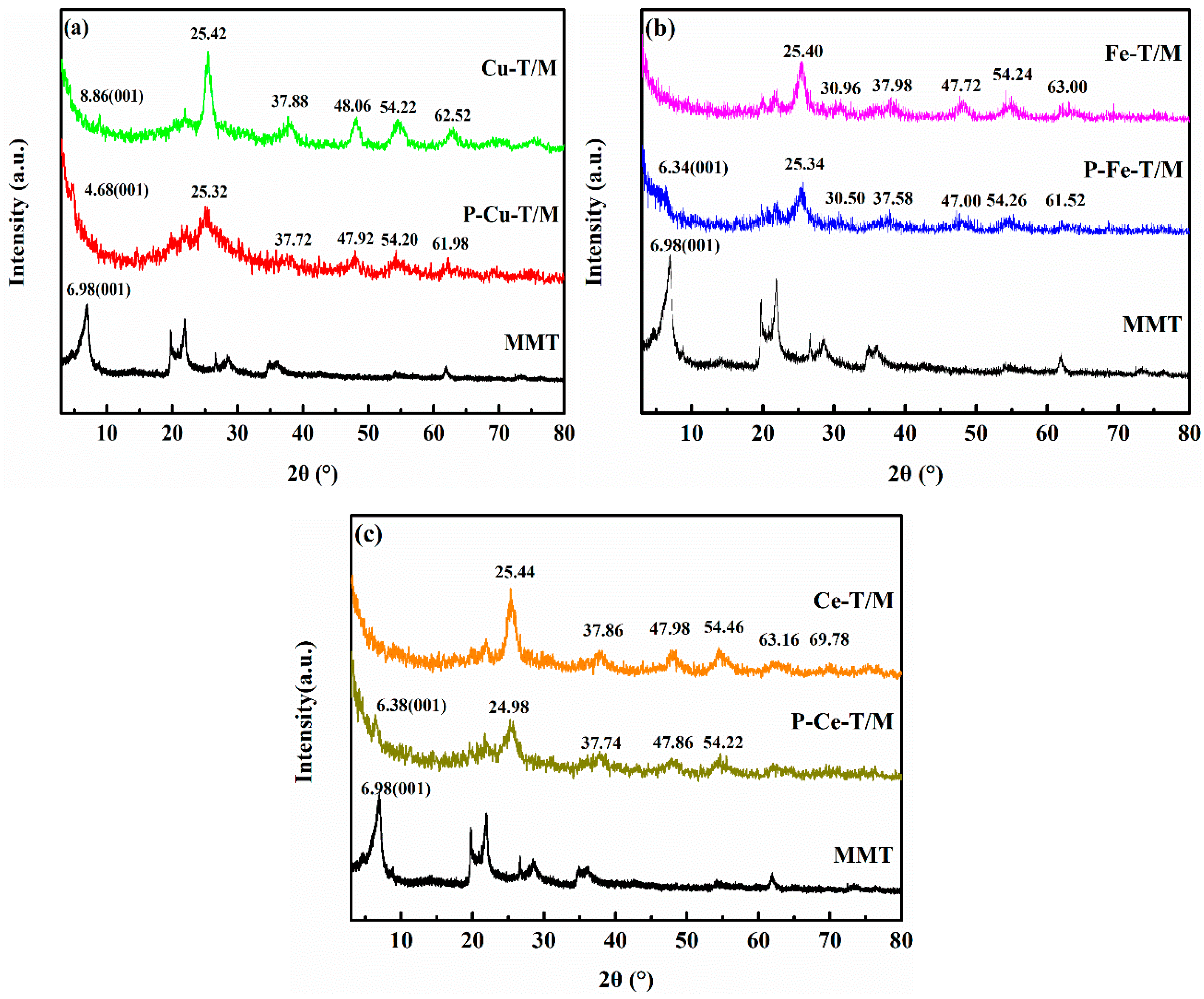
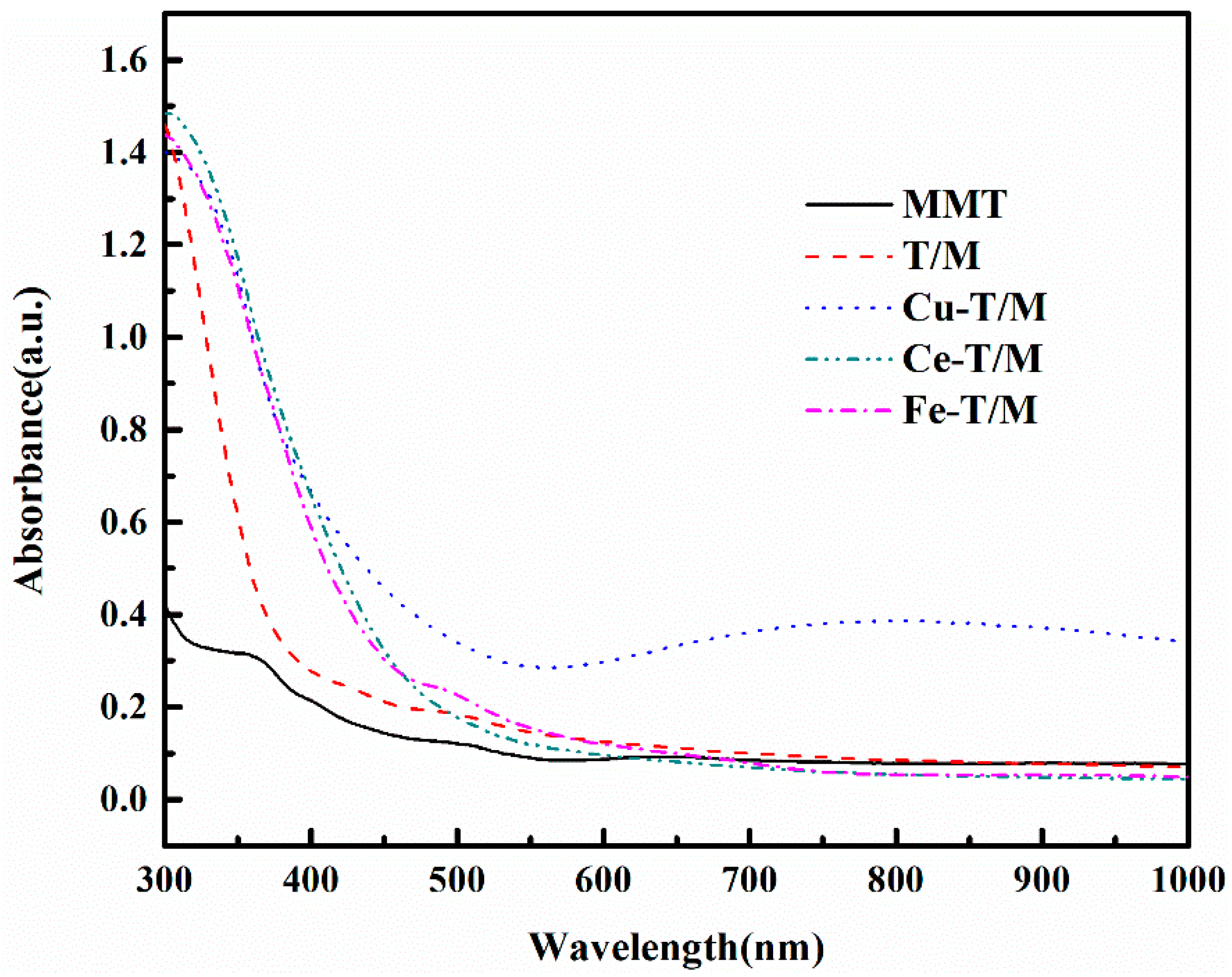
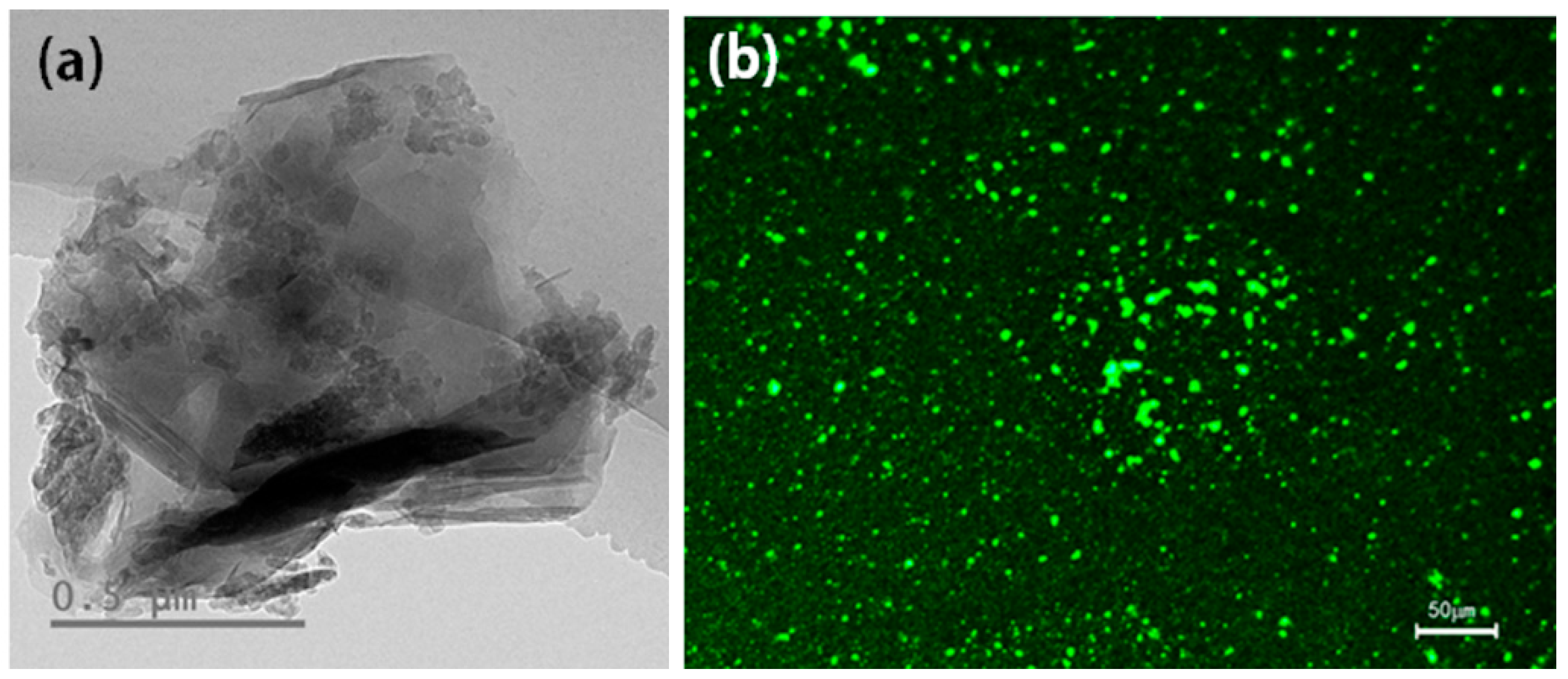
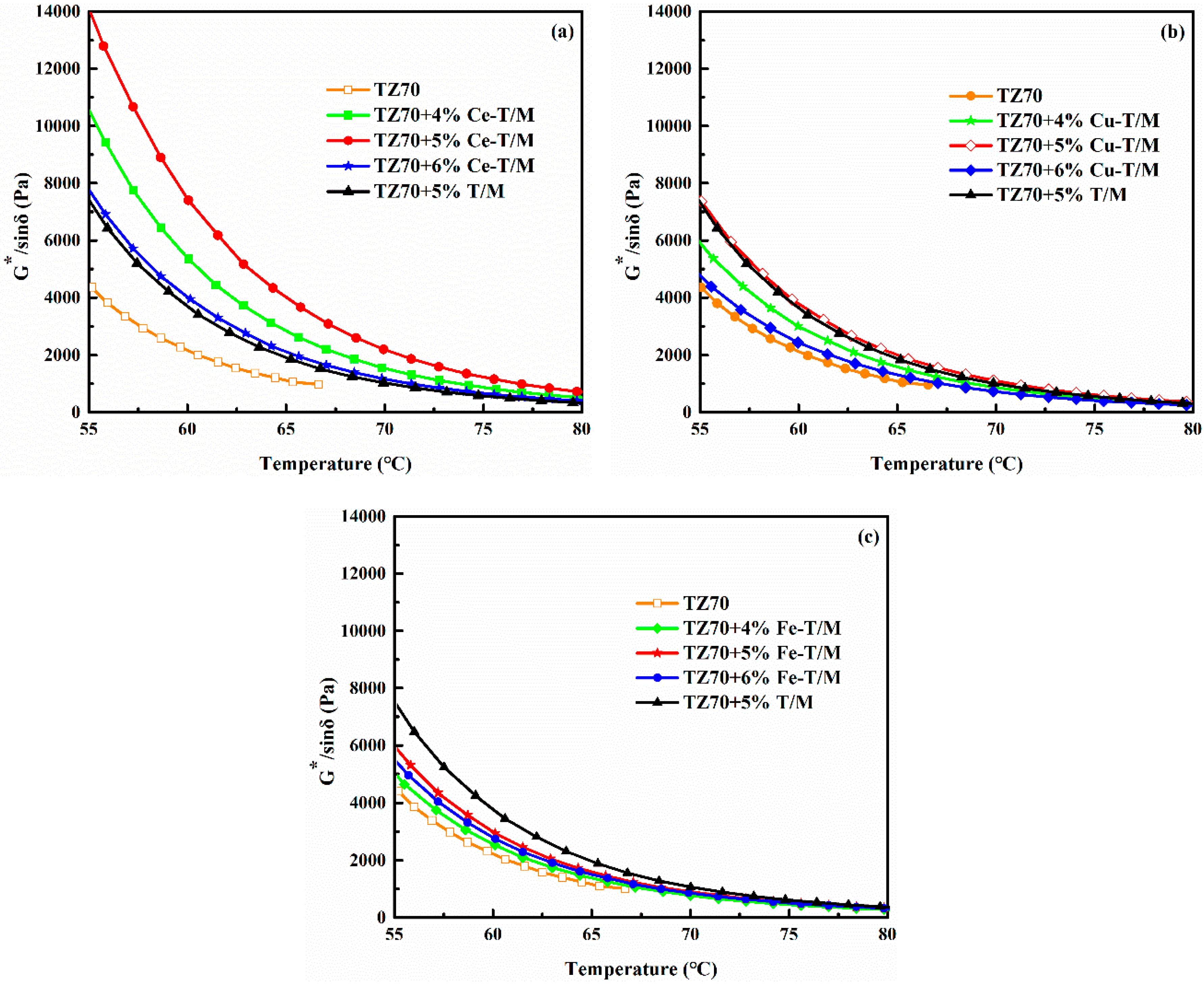

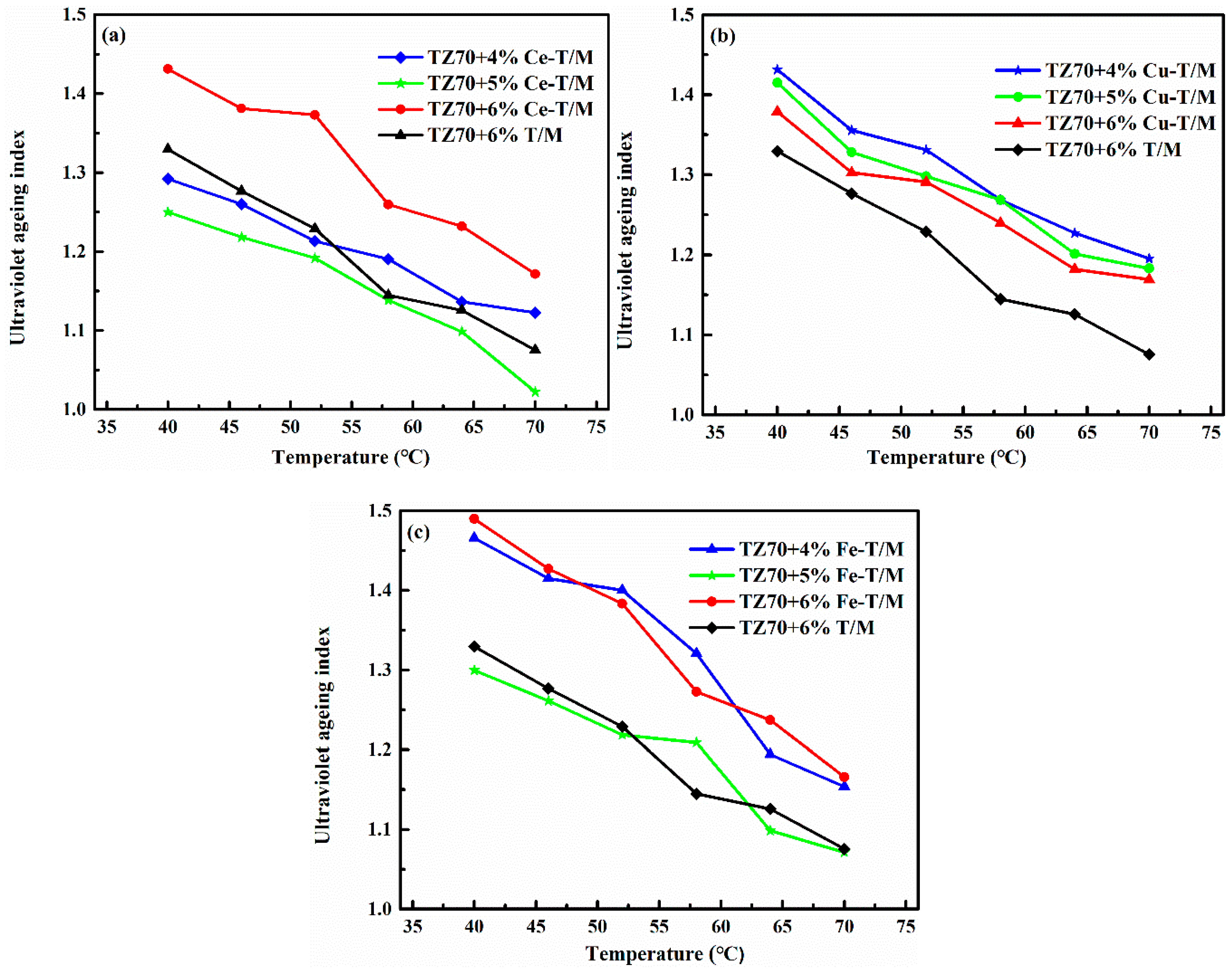
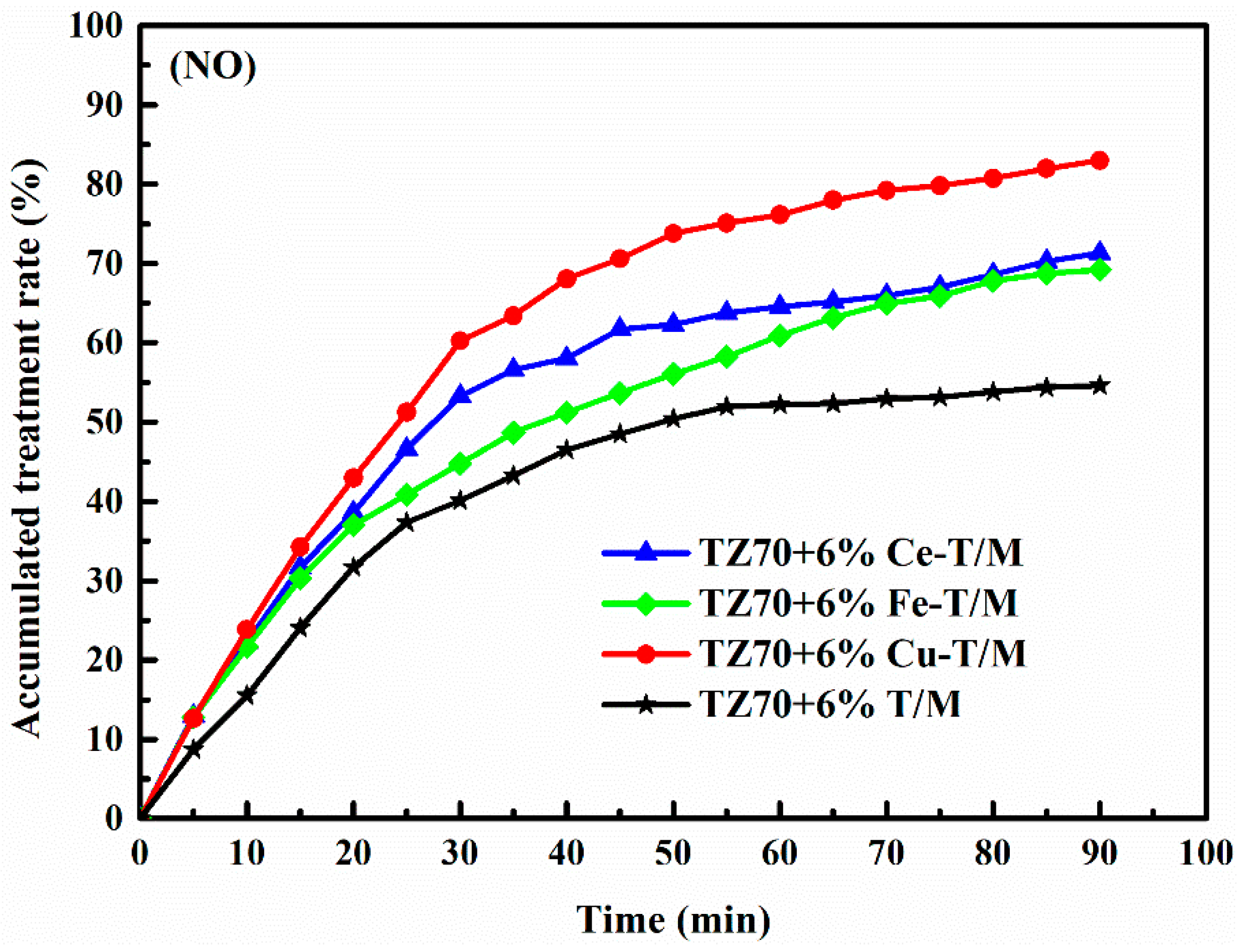
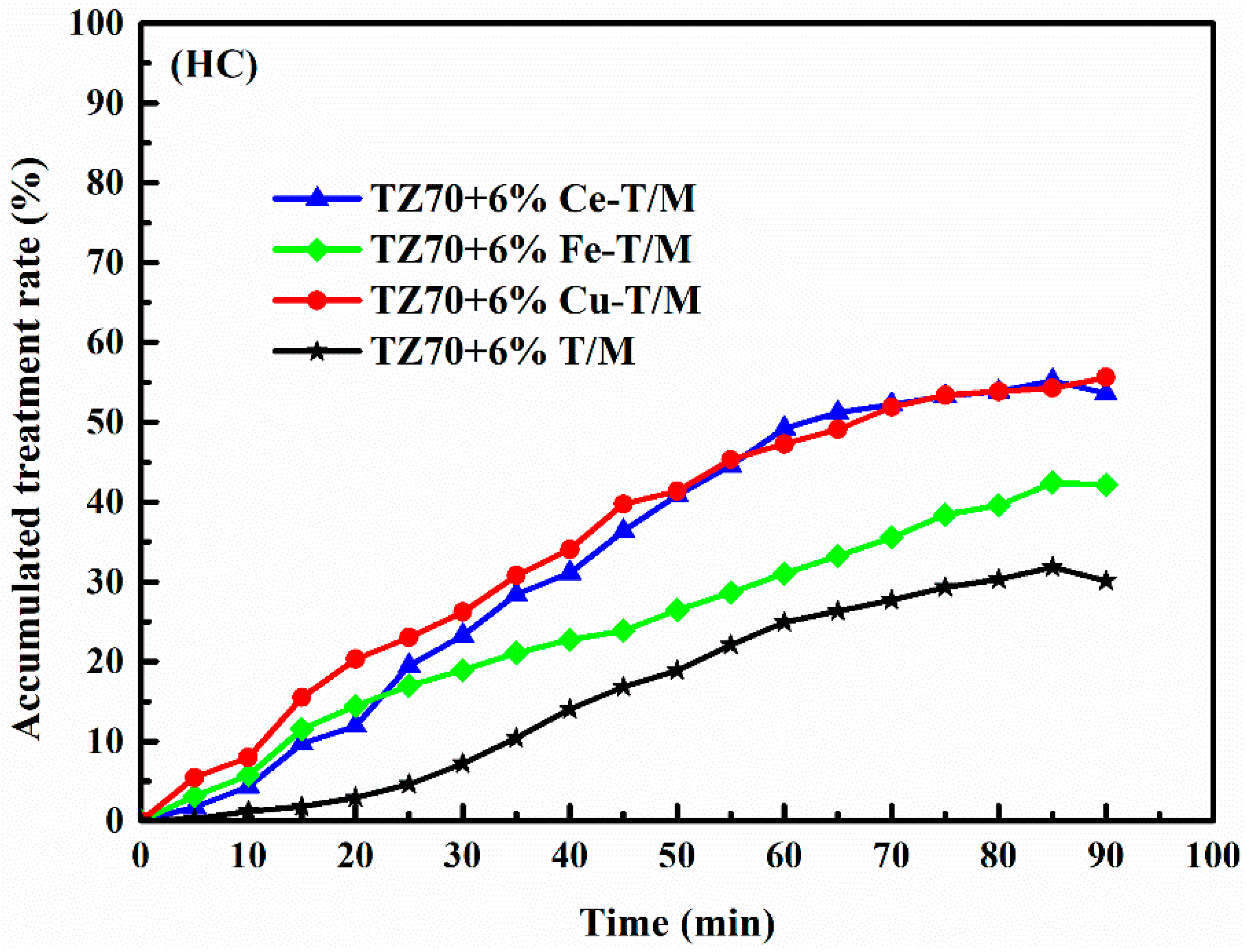
| Properties | Limitation | Values |
|---|---|---|
| Penetration (25 °C, 100 g, 5 s), 1/10 mm | 60~80 | 68.2 |
| Penetration index | −1.5~+1.0 | −1.06 |
| Softening point, °C | ≥46 | 47.3 |
| Ductility (15 °C, 5 cm/min), cm | ≥100 | >148 |
| Dynamic viscosity (60 °C), Pa·s | ≥180 | 195 |
| Density (15 °C), g/cm3 | — | 1.026 |
| Sample Types | X-ray Diffraction (Powder) | UV-Vis Spectra (Powder) | High Temperature Rheological (Bitumen) | UV Aging (Bitumen) | Automobile Exhaust Degradation (Bitumen) |
|---|---|---|---|---|---|
| Original bitumen | √ | √ | |||
| MMT | √ | √ | |||
| T/M | √ | √ | √ | √ | |
| Ce-T/M | √ | √ | √ | √ | √ |
| Cu-T/M | √ | √ | √ | √ | √ |
| Fe-T/M | √ | √ | √ | √ | √ |
| Bitumen Types | Critical High Temperature | Temperature Change |
|---|---|---|
| Original bitumen | 65.37 °C | — |
| 5 wt % T/M | 70.29 °C | +4.92 °C |
| 4 wt % Ce-T/M | 73.81 °C | +8.44 °C |
| 5 wt % Ce-T/M | 78.08 °C | +12.71 °C |
| 6 wt % Ce-T/M | 71.39 °C | +6.02 °C |
| 4 wt % Cu-T/M | 69.06 °C | +3.69 °C |
| 5 wt % Cu-T/M | 73.05 °C | +7.68 °C |
| 6 wt % Cu-T/M | 67.54 °C | +2.17 °C |
| 4 wt % Fe-T/M | 66.02 °C | +0.65 °C |
| 5 wt % Fe-T/M | 67.25 °C | +1.88 °C |
| 6 wt % Fe-T/M | 66.80 °C | +1.43 °C |
© 2019 by the authors. Licensee MDPI, Basel, Switzerland. This article is an open access article distributed under the terms and conditions of the Creative Commons Attribution (CC BY) license (http://creativecommons.org/licenses/by/4.0/).
Share and Cite
Jin, J.; Chen, B.; Liu, L.; Liu, R.; Qian, G.; Wei, H.; Zheng, J. A Study on Modified Bitumen with Metal Doped Nano-TiO2 Pillared Montmorillonite. Materials 2019, 12, 1910. https://doi.org/10.3390/ma12121910
Jin J, Chen B, Liu L, Liu R, Qian G, Wei H, Zheng J. A Study on Modified Bitumen with Metal Doped Nano-TiO2 Pillared Montmorillonite. Materials. 2019; 12(12):1910. https://doi.org/10.3390/ma12121910
Chicago/Turabian StyleJin, Jiao, Bozhen Chen, Lang Liu, Ruohua Liu, Guoping Qian, Hui Wei, and Jianlong Zheng. 2019. "A Study on Modified Bitumen with Metal Doped Nano-TiO2 Pillared Montmorillonite" Materials 12, no. 12: 1910. https://doi.org/10.3390/ma12121910






